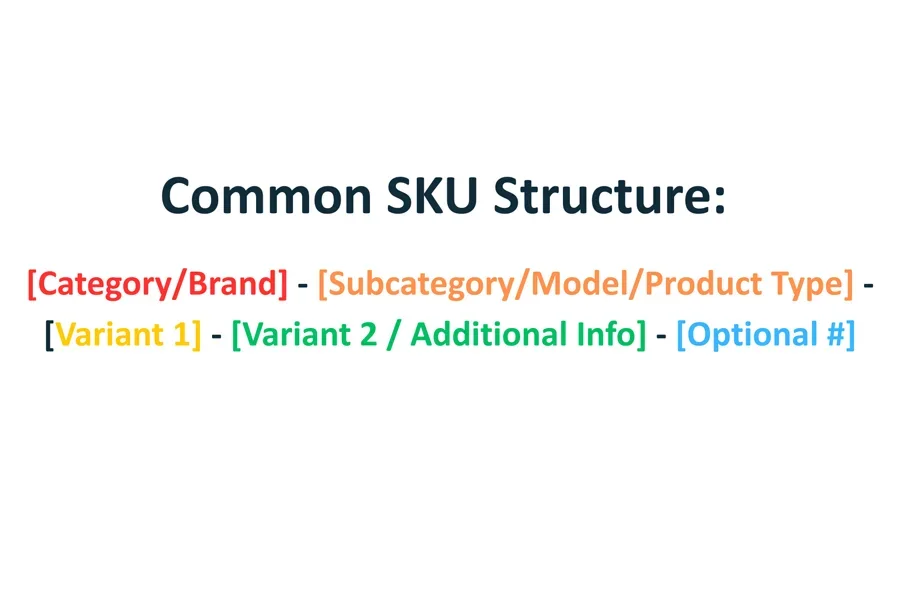Imagine having to cut down on paper and postage when writing a letter. One ingenious yet challenging method, popular back in the 1800s, was the practice of crossed letters, where the writer wrote the letter further at a 90-degree angle, overlapping the original text at times.
As a result, this often made letters harder to decipher, even though it allowed far more words to fit on a single sheet. Thankfully, such tedious saving practices ended with the invention of the earliest form of the postal code in 1857, which finally made postage fees far more reasonable and affordable through a systematic mail categorization.
Indeed, in today’s complex world, various classification systems serve critical roles in organizing complicated workflows of different industries. SKU (stock keeping unit), for example, groups products to bring order out of chaos, developing a standard system amid complexity. To better manage stock and inventory levels, continue reading to learn the definition of SKU, its use cases, and how to create SKUs.
Table of Contents
Understanding stock keeping units (SKU)
What an SKU means
Why SKUs matter
Key use cases for SKUs
For inventory-heavy sectors
For service-diverse industries
For sales improvement
How SKUs are assigned & common examples
How to create SKUs
Common SKU structures and examples
Inventory tracking simplified
Understanding stock keeping units (SKUs)
What an SKU means

A stock keeping unit (SKU) is an in-house identifier created by different companies, usually retailers or businesses with many product or service variations, to simplify product categorization. It is primarily used for inventory tracking, product data management, and analysis, among other purposes.
This means that an SKU is essentially a condensed product or service description at a glance. Each SKU uniquely represents a distinct product variant and consists of components reflecting the particular product attributes. These include brand, model, color, material, measurements, and even info related to target users (gender, age, etc.), which help to easily identify its look for internal sorting.
To maximize the descriptiveness of SKU, it’s usually in alphanumeric format and comes with an average length of 8 to 16 characters, even though there’s no universal requirement or standard for the SKU system since its creation and assignment are purely seller-invention.
Why SKUs matter
At its core, SKU provides a consistent, quick, and systematic way for inventory tracking/management, eliminating lengthy, confusing descriptions while making it more straightforward for employees to learn and apply in daily operations. Depending on its structure, any alphanumeric SKU can also function as a barcode if equipped with a scanning system that accepts it. Overall, SKU simplifies the tracking of the product’s journey, from arrival to final sale, facilitating stock monitoring and planning to ensure sufficient stock levels are maintained with timely reordering.
From a product data analysis perspective, the much-optimized SKU also provides better, faster insight into popular or lagging products and the overall peak/off-peak season impact on any particular product sales. In terms of order fulfillment, the clear-cut, shorthand structure of SKU info further aids in reducing potential issues, as it streamlines the entire fulfillment process with fewer mistakes, leading to greater customer satisfaction.
Key use cases for SKUs
For inventory-heavy sectors

SKUs are especially helpful for inventory-intensive businesses where warehouses and logistics management are heavily dependent and complex. In this sense, most companies in the retail sector, including both offline retail stores and online sellers, can leverage SKUs to efficiently manage their stock and catalogs.
Meanwhile, aside from retail and eCommerce, SKUs are beneficial for any industry where supply chain integration, order tracking, and supplier coordination for everything from raw materials to finished products are essential. This includes manufacturing, wholesale distribution, and fulfillment centers, as SKUs help businesses optimize inventory tracking.
At the same time, it’s important to note that, in addition to SKUs, there are other universal barcode systems used in inventory management; however, these systems are mostly subscription-based and fundamentally different from SKUs. They are typically required only when businesses deal with large retailers such as Walmart and Amazon, as international product codes like UPC (Universal Product Code) and EAN (European Article Number) standardize global tracking and checkout through a universal scanning system.
For service-diverse industries

Even though SKUs are mostly used for businesses with many product variations, they are equally useful for service-based items. For example, a company that sells physical products may also offer various non-physical, service-based options, such as warranty plans, repair services, or extended support packages.
Meanwhile, service-driven industries like spas, beauty salons, and healthcare may also assign SKUs to different types of services to cater to a wide range of clientele and customizable packages. More often than not, these service-centric fields rely on structured tracking systems to coordinate schedules, manage pricing strategies, and track essential resources.
For sales improvement

Another often-overlooked use case of SKUs is their role in product data analysis, which can be utilized to analyze customer purchasing behavior, identify top-selling items, and support strategic cross-selling. For example, based on frequently purchased SKUs, sellers can recommend additional related products to buyers or create product bundles and special promotions based on popular SKU combinations to encourage larger purchases.
SKU analysis can also enhance personalized shopping experiences through tailored product ideas and targeted marketing campaigns. This not only reduces order errors and returns but also helps to boost overall sales performance and customer satisfaction.
How SKUs are assigned & common examples
How to create SKUs

SKUs are created and assigned to different products based on their defining characteristics and key attributes that make them easier to identify. Although the creation of SKUs largely depends on product type and industry, there are a few general best practices to follow for an efficient SKU creation process.
1) Incorporate a standardized format with relevant attributes
All SKUs should follow a fixed, standardized format that applies across all product variants. To ensure a consistent SKU structure, businesses should categorize their products before assigning SKUs. Products should be grouped based on shared characteristics, serving as a preparation step that helps streamline the subsequent SKU creation process significantly.
2) Make each SKU unique
When categorizing products and creating relevant abbreviations for their attributes, businesses must ensure consistency while also maintaining SKU uniqueness for each product variant or even at the itemized level if needed.
3) Keep SKUs short and readable
Use clear and recognizable abbreviations to represent attributes. For example, PUR is often used to indicate the color purple, whereas LTH-JKT is easily identifiable as a leather jacket.
Most companies use hyphens as optional separators for different segments within SKUs while avoiding spaces or special characters. An important consideration is to avoid starting an SKU with zero, a prefix that many software systems may potentially overlook or misinterpret, causing unpredictable errors in data processing.
4) Opt to generate SKUs via third-party
Although product categorization and internal SKU creation are not overly complex, especially for those with a small and simple product line, business owners can save more time by delegating this task to third-party software, such as a POS (point-of-sale) system or inventory management software.
Most inventory or POS systems come with built-in SKU generators and tracking mechanisms. In fact, many find it easier to automate SKU creation rather than manually coding everything. A general best practice is to take full advantage of these tools while also incorporating internal customized SKU rules to ensure SKUs remain relevant to operations.
For those with long-term, dedicated suppliers, another alternative is to adopt the codes provided by suppliers or integrate their system directly into POS or inventory software for seamless SKU tracking and management.
Common SKU structures and examples
Common SKU structure

To better understand how businesses generate and assign SKUs, let’s explore their general structure based on a common five-segment SKU format:
[Category/Brand] – [Subcategory/Model/Product Type] – [Variant 1] – [Variant 2 / Additional Info] – [Optional #]
Each segment plays a key role in SKU structure, as outlined in the description below.
Segment 1: [Category/Brand]
- Purpose: This identifies either the broad product category (e.g., fashion, electronics) or the company/brand abbreviation (e.g., FA for a fashion label).
- Examples: “ELE” for electronics, or “ADI” for the Adidas brand.
- When to use/skip: This segment is optional and can be used interchangeably between
Category and Brand if:
- The brand name is already included elsewhere (e.g., in Segment 2).
- The business focuses on a single broad category (e.g., only fashion items), so a subcategory is unnecessary. In short: If brand recognition is the priority, skip “Category.” Conversely, if category differentiation is more important, omit “Brand” instead.
Segment 2: [Subcategory / Model / Product Type]
- Purpose: This provides a more specific classification beyond the broad category or brand. This segment breaks down the main category or differentiates between product types/models.
- Examples: “TST” for T-shirt or “S10” for Samsung Galaxy S10.
- When to use/skip: Businesses can use this when multiple product types require distinction within a category but should skip when dealing with a single product category or a limited range of products, where additional classification is unnecessary.

Segment 3: [Variant 1]
- Purpose: This captures the main attribute(s) that distinguish variations: color, size, or capacity.
- Examples: “BLK” for Black or “64G” for 64GB storage.
- When to use/skip: Businesses can use this segment when products have multiple variations but should skip this if no variations exist. If multiple attributes apply, a combination is recommended (e.g., “BLM” for Black, Medium).
Segment 4: [Variant 2 / Additional Identifier]
- Purpose: This provides additional details such as seasonality, regional availability, or batch info.
- Examples: “SP23” for Spring 2023 or “US” for the U.S. region.
- When to use/skip: Businesses can use this when tracking product releases, regional variations, or any additional classification. But one can skip this if no additional info is involved; keep it short for an efficient length.
Segment 5: [Optional, Itemized Unique Number]
- Purpose: This assigns a unique item-level identifier for tracking each physical unit individually.
- Examples: “0001” (serial number) or “5678” (for example, the last 4 digits of the barcode).
- When to use/skip: This optional numeric part is used only for precise, item-level tracking if needed. Businesses can skip this if tracking by variant alone is sufficient. In fact, most businesses do not require such itemized details for general inventory management.
Finally, regardless of the segment, the general rule of thumb is to use short abbreviations of 2–4 characters and ensure each segment contains only one component per product variant. Keep the SKUs within the 16-character limit (excluding dashes) for simplicity and readability.
SKU examples

For a hands-on experience in SKU creation and to get a clear understanding of how the above common SKU structure works, let’s now put it into practice for the top three common categories: fashion, consumer electronics, and health/beauty products.
All 4 or 5 segments (including or excluding the last optional segment) can be maintained to adapt the abbreviations. These examples may serve as a template, and anyone can apply abbreviations to fit their product lines as long as they are consistent, precise, and unique.
1) Fashion
SKU: FA-TST-MLBK-F23-01
Length (excluding dashes): 2 + 3 + 4 + 3 + 2 = 14 characters
Segment Breakdown:
- FA → Brand or Category (Fashion)
- TST → Product Type (T-Shirt)
- MLBK → Variant 1 (Medium, Black)
- F23 → Variant 2 / Additional Identifier (Fall 2023)
- 01 → Optional Unique Number (optional item-level code)
2) Consumer electronics
SKU: ELE-PH-S1064G-US-123
Length (excluding dashes): 3 + 2 + 6 + 2 + 3 = 16 characters
Segment Breakdown:
- EL → Category or Brand (Electronics)
- PH → Subcategory (Phone)
- S1064G → Variant 1 (Galaxy S10 64GB) or (S10 64GB Green). The exact meaning depends on the chosen abbreviation; it’s important to keep it concise.
- US → Variant 2 / Additional Identifier (Region code, e.g., US)
- 123 → Optional Unique Number
3) Health & beauty products
SKU: HB-LP-RDM2-SPF50
Length (excluding dashes): 2 + 2 + 4 + 5 = 13 characters (no optional item code here)
Segment Breakdown:
- HB → Category/Brand (Health & Beauty)
- LP → Product Type (Lip product)
- RDM2 → Variant 1 (Red Matte #2) or “REDM” if preferred
- SPF50 → Variant 2 / Additional Identifier. If space is limited, use ‘SPF5’ to represent SPF 50.
- (If an itemized number is required, add 2–3 digits at the end but keep it within the total limit.)
Inventory tracking simplified

An SKU is a short-form product or service description that aids in inventory categorization and management. It is applicable across various POS systems and inventory software, hence, it is ideal for simplifying inventory tracking. While SKUs are commonly used in inventory-heavy sectors, they are also valuable for service-focused industries, especially for those offering a wide range of services.
SKUs are often leveraged to improve sales performance due to their ease of identification and flexibility; companies use them to enhance product recommendations and create related bundled promotions. Businesses can create custom SKUs from scratch, provided they are standardized, concise, and distinctive. Alternatively, vendor codes can be adopted, or SKUs can be automatically generated using POS systems or inventory management software.
Visit Alibaba.com Reads regularly for expert inventory management guides, logistics insights, and wholesale business strategies. Unlock new opportunities and expand wholesale expertise starting today!



